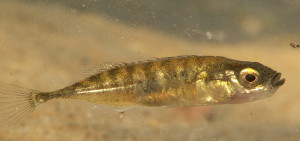 The fish has an elongated bare body with a thin caudal peduncle and a short snout; only the side keels of the caudal peduncle are covered with small bone plates. The gill membranes are merged, comprising a broad and free fold across the isthmus. Front of the dorsal fin, there are 7-12 small spines pointing sideways in zigzag manner. The pelvic fins morphed into spines. The fish can be 9 cm long, with the average of 5-6 cm. In the breeding season, males turn completely black. This stickleback is more of a northern and freshwater species than the three-spine. It is widespread in the basin of the Arctic Ocean, Baltic and NorthSeas. It mainly dwells in freshwater, but can occur in the brackish waters of lagoons and bays. It spawns in the shed of the White Sea in June-August. Like in many other sticklebacks, several females lay eggs in the same nest. Their spawning is intermittent, with the fertility of 350-960 eggs. Males build nests and guard the roe. In contrast to the three-spine sticklebacks, these males build nests on stems of submerged plants instead of the ground soil.
The fish has an elongated bare body with a thin caudal peduncle and a short snout; only the side keels of the caudal peduncle are covered with small bone plates. The gill membranes are merged, comprising a broad and free fold across the isthmus. Front of the dorsal fin, there are 7-12 small spines pointing sideways in zigzag manner. The pelvic fins morphed into spines. The fish can be 9 cm long, with the average of 5-6 cm. In the breeding season, males turn completely black. This stickleback is more of a northern and freshwater species than the three-spine. It is widespread in the basin of the Arctic Ocean, Baltic and NorthSeas. It mainly dwells in freshwater, but can occur in the brackish waters of lagoons and bays. It spawns in the shed of the White Sea in June-August. Like in many other sticklebacks, several females lay eggs in the same nest. Their spawning is intermittent, with the fertility of 350-960 eggs. Males build nests and guard the roe. In contrast to the three-spine sticklebacks, these males build nests on stems of submerged plants instead of the ground soil.
/ * The photos at lake.peipsi.org are cross-posted from commons.wikimedia.org and are used for familiarization purposes only. No commercial use of the photos is allowed. For more information about to use the photos see the originals on commons.wikimedia.org. /


